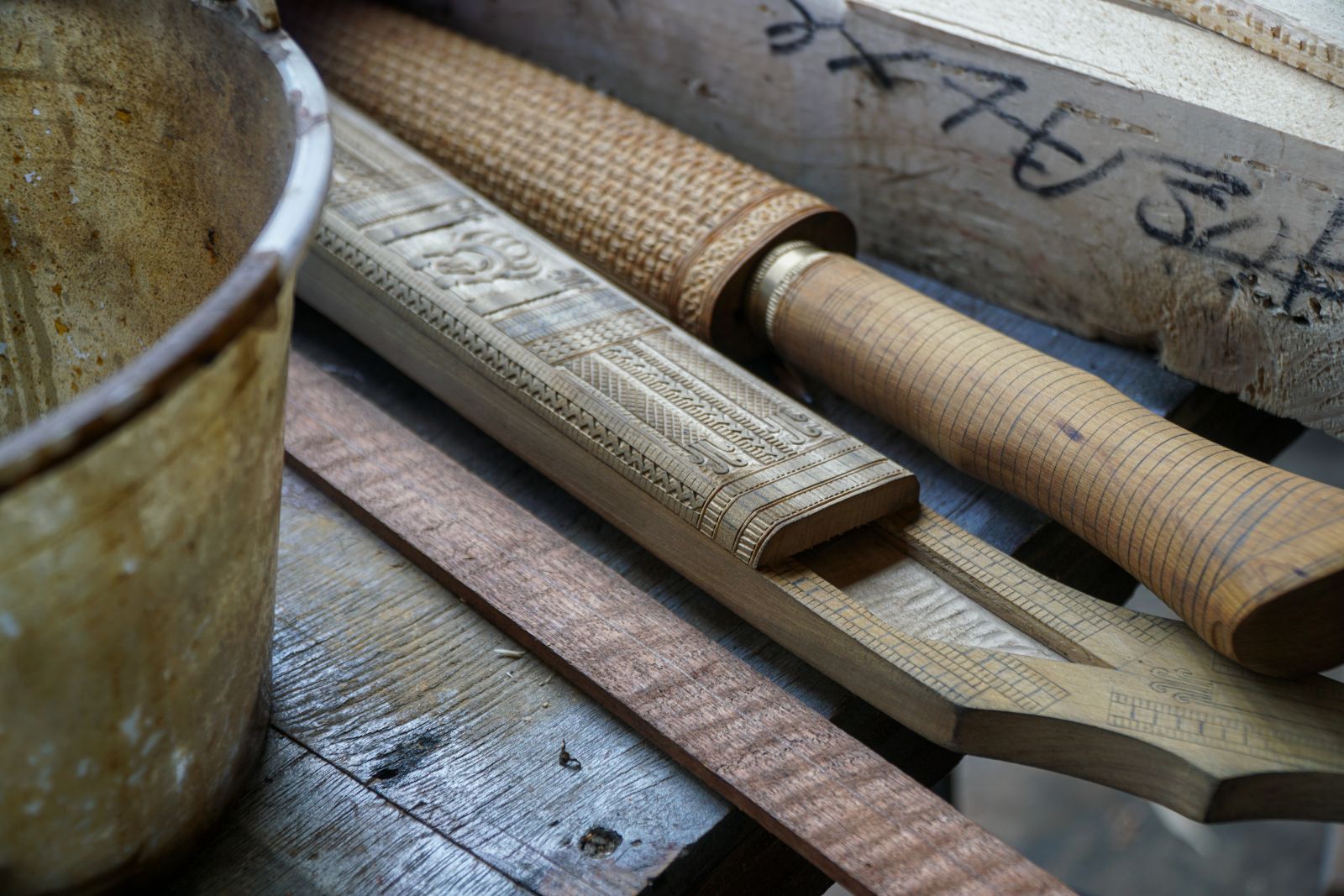專欄
走進部落,與佩刀的藝術美學相遇-高獻庭:「刀,是回家的鑰匙。」 Walk into the Tribe for Encountering the Art of Sword. Kuciling Katatepan said, “The Sword is the Key to Home.”
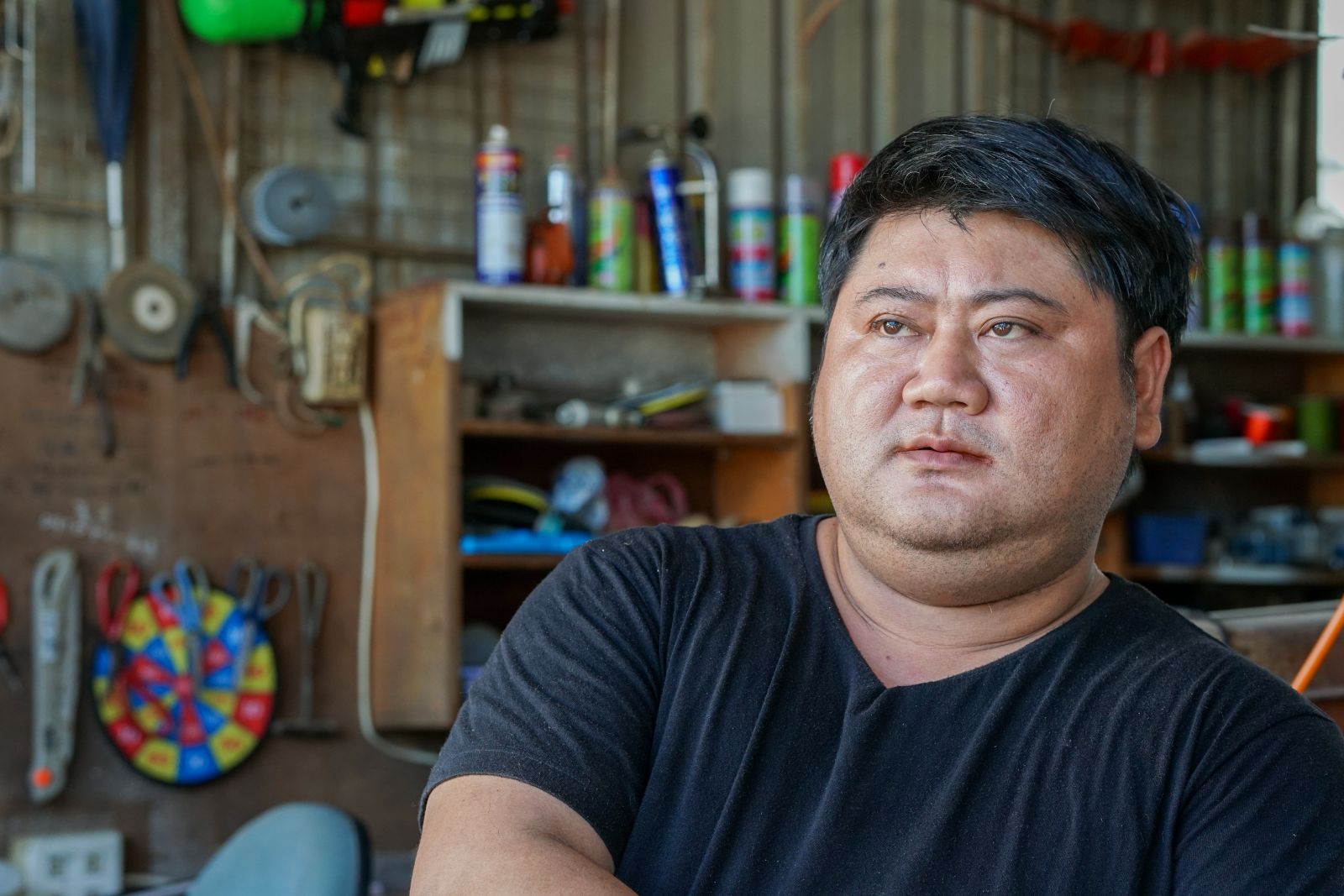
熾熱的陽光映照著寶藍色的太平洋,晴天的臺十一色彩總讓人移不開眼球,吹著海風一路向南,我們來到位於臺東的知本部落,又名卡大地布部落(Katratripulr),沿著在地人稱為「知本第二條路」的西昌路走,溫潤的木香引領我們緩緩前進,我們已到達今日主角-高獻庭的工作室了!一進到工作室,首先映入眼簾的是五顏六色的工藝牆,甚是壯觀,他邀我們坐下,以閒散的步調開啟談話。高獻庭,知本部落卑南族人,族名Kuciling Katatepan,現為藝術工作者,創作媒材以木頭為主,包括佩刀雕刻、傢俱客製、傳統器具製作、裝置藝術陳設等,其中以佩刀作品最廣為人知。
The blazing sun shone on the royal blue ocean, and it was so eye-catching. Blowing in the wind, we straightly went to the south part of Taitung, afterwards, we arrived at Chihpen Tribe, which were also known as Katratripulr. When walking along XiChang Road, which locals called “the second road of Chihpen”, the gentle woody smell led us forward, then we arrived at Xian-Ting's studio. When entering his studio, a colorful and spectacular tool wall came into view, Xian-Ting invited us to sit down, and started a conversation at the most comfortable pace. Xian-Ting Gao, an Pinuyumayan man in Katratripulr, native name Kuciling Katatepan, an art worker now, mainly creates works of wood, including sword sculpture, custom-made furniture, traditional craft and installation art, and especially best known for sword sculpture.
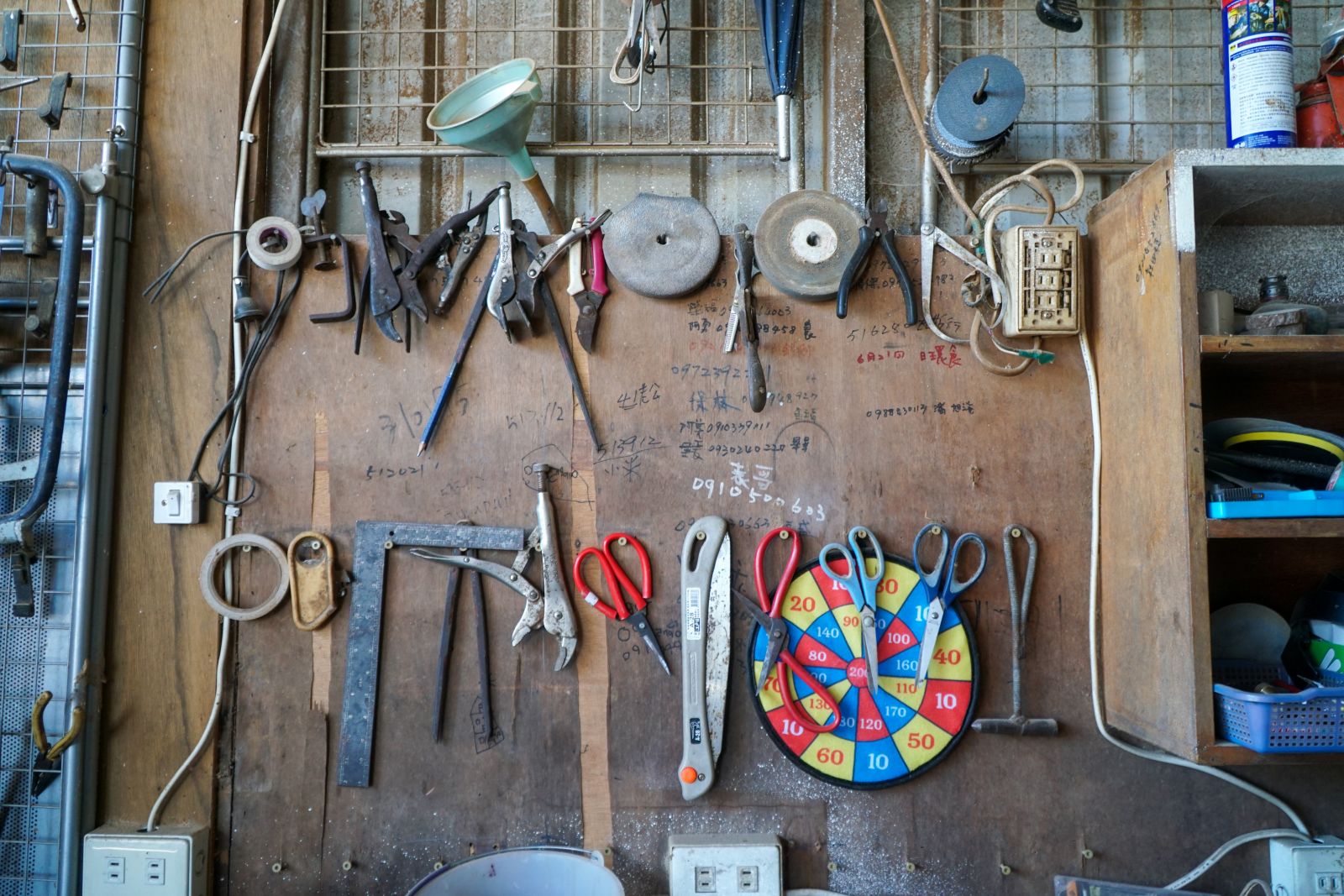
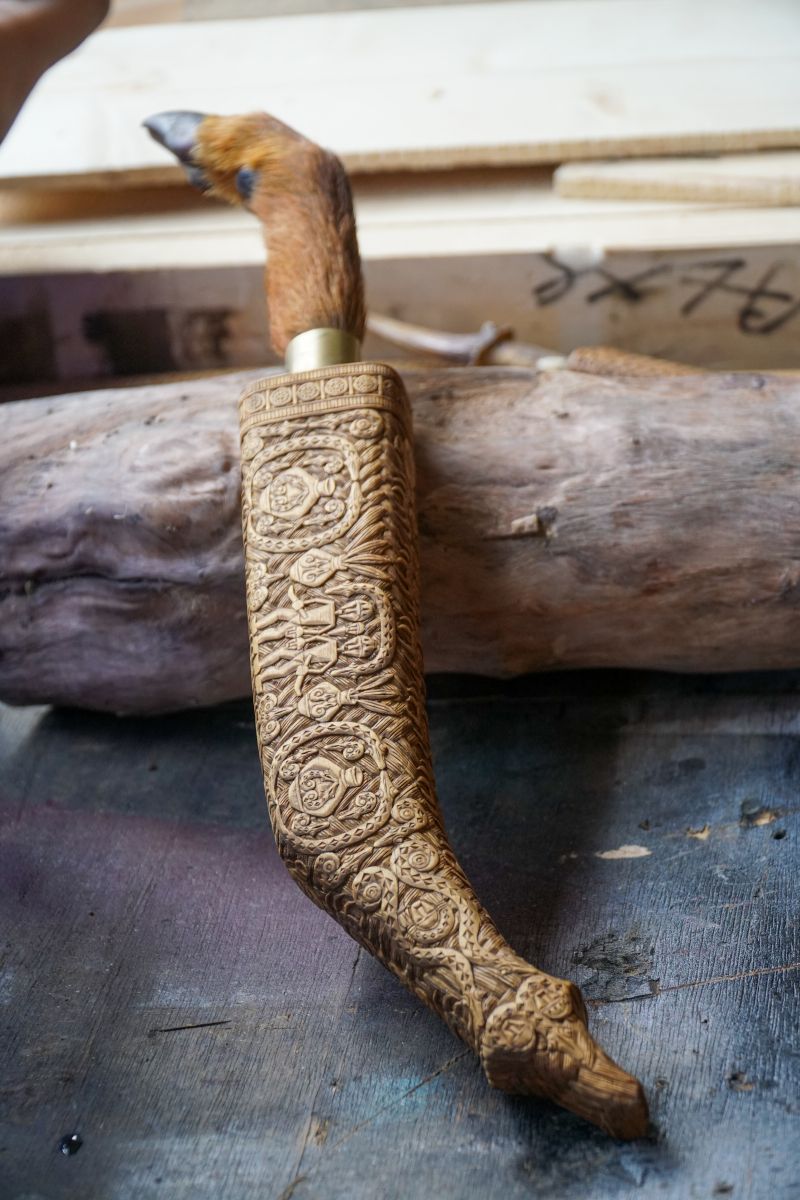
獻庭的佩刀以其精準的工法、精緻的雕刻以及獨一無二的刀柄刀鞘形狀聞名。當我們仔細欣賞桌案上的鬼斧神工,不難看出獻庭對文化的認同以及傳承的堅持。問起學習歷程,他回答:「我人生第一次雕刻,是在15歲那年。」獻庭的祖母擅長做傳統服飾,小時候他都會幫忙做些簡單的工作,對於用雙手創造實物這件事,他從小熟悉起,加上本身是一個愛畫畫的孩子,童年早已充滿創作能量。某次在家畫畫時,長輩問他:「你畫那麼久了,想不想刻刻看?」他記得當時很緊張地問:「真的嗎?失敗怎麼辦?」長輩只回:「試試看啊!」從此之後,獻庭拜長輩為師,跟隨他學習雕刻技藝。
Xian-Ting’s sword always amazes people with its precise methods, exquisite looks and unique shapes. We took a deep look into his work, and literally saw the identity of culture and the persistence of inheritance. When talking about the learning journey, he said “ My first carving experience happened at 15 years old. “ Xian-ting’s grandmother was good at making traditional clothes, hence, he used to do some simple works for her. He had gotten acquainted with creating something by his own hand when he was really little, additionally, he loved to paint. All these things made his childhood filled with creative energy. One day, while he was painting at home, an elder of his family asked him, “You have painted for a long time. Do you want to carve it on something?” He remembered he said nervously, “Really? What if I fail?“ The elder only replied “Just give it a try.” Since then, Xian-ting took the elder as his teacher, following him to learn the sculpture artistry.
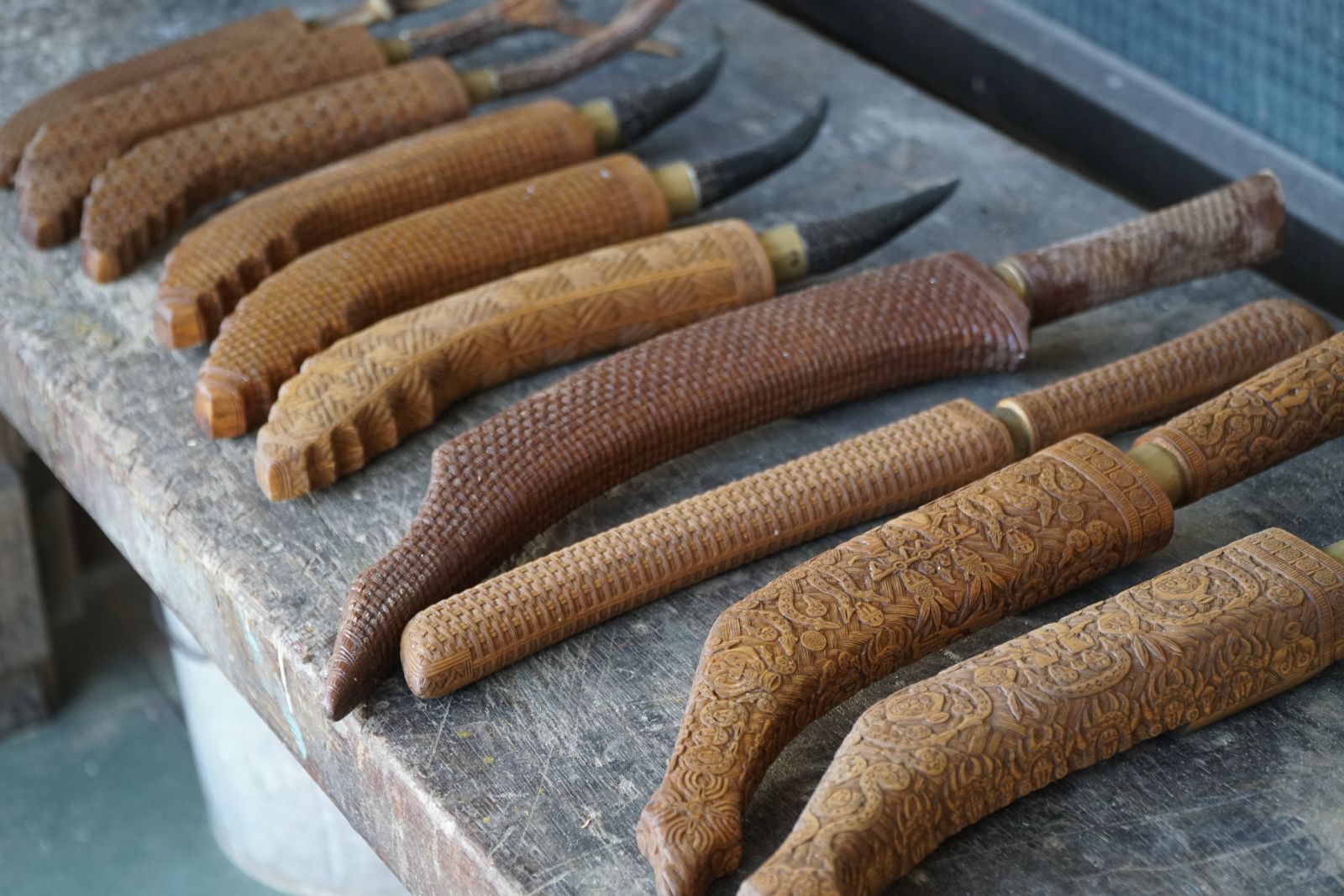
「對我來說,刀的意義有很多層次。」獻庭曾經嘗試過許多不同的創作形式,經過一段時日的摸索,才以佩刀創作為專精,問起為什麼選擇刀,獻庭說:「第一,從創作層面來說,雕刻刀與我息息相關。雕刻的本質,就是去除該刪減的部分、留下該保存的部分,而刀子在過程中坐擁著至關重要的地位,每一刀敲擊,都是一次重塑,呈現出來的視覺觀感與整體曲線都會有所變化,細究到刀痕之間的平衡感,雕刻的美從中淬煉而出。第二,從生活層面來說,刀子對卑南族男人的生命意義至關重大。大約10-12歲,男孩們會相繼住進部落的青年會所,我們稱為巴拉冠(Palakuwan),所有青年一起生活、學習與成長,並接受各個年齡層的考驗,而每當通過考驗,家族長輩就會贈與不同的刀子。起初,男孩們開始學習如何處理獵物、砍劈藤竹時,會獲得人生第一把刀,族語稱為Kamatr,是一把長度約15公分的短刀。而當我們年滿16歲,傳統上經過獵首的洗禮後,則會被授與一把禮刀,族語稱為Tazaw,主要於祭典儀式等需盛裝出席的場合佩戴。因此刀對我們來說,象徵著個體的成長,也代表著文化的榮耀。」
“For me, the meaning of sword is stratified.” Xian-ting had tried a lot of creative ways, after a period of groping, he decided to spend most of time in sword sculpture. Asking him why he chose the sword as his main creation, he answered, “ First, the carving knife is closely related to my creation. The sculpture is about removing something not needed and keeping something needed. In the process of making sculpture works, the knife plays a vital role. Every cut and chop is a reshape, presenting different visual perception and overall curve, even relating to the balance between cuts, all details quench the beauty of sculpture.” “Second, for a Pinuyumayan man, the sword occupied an important position in life. About 10-12 years old, all boys who live in the tribe will move into a men's house, which is called Palakuwan. We will live, learn, and take the test for different age levels together, and when we get through the test, the elder will give a sword to us as a gift. For example, in the beginning, when we learn to deal with prey and chop down bamboo, we’ll be given the first sword of our life, Pinuyumayan named Kamatr, it’s a short knife about 15 centimeters long. And when we’re 16 years old, traditionally after headhunting, we’ll be given a salute knife, called Tazaw, mainly for the dressing-up occasion. Therefore, the sword symbolizes not only personal growth but also cultural glory.“
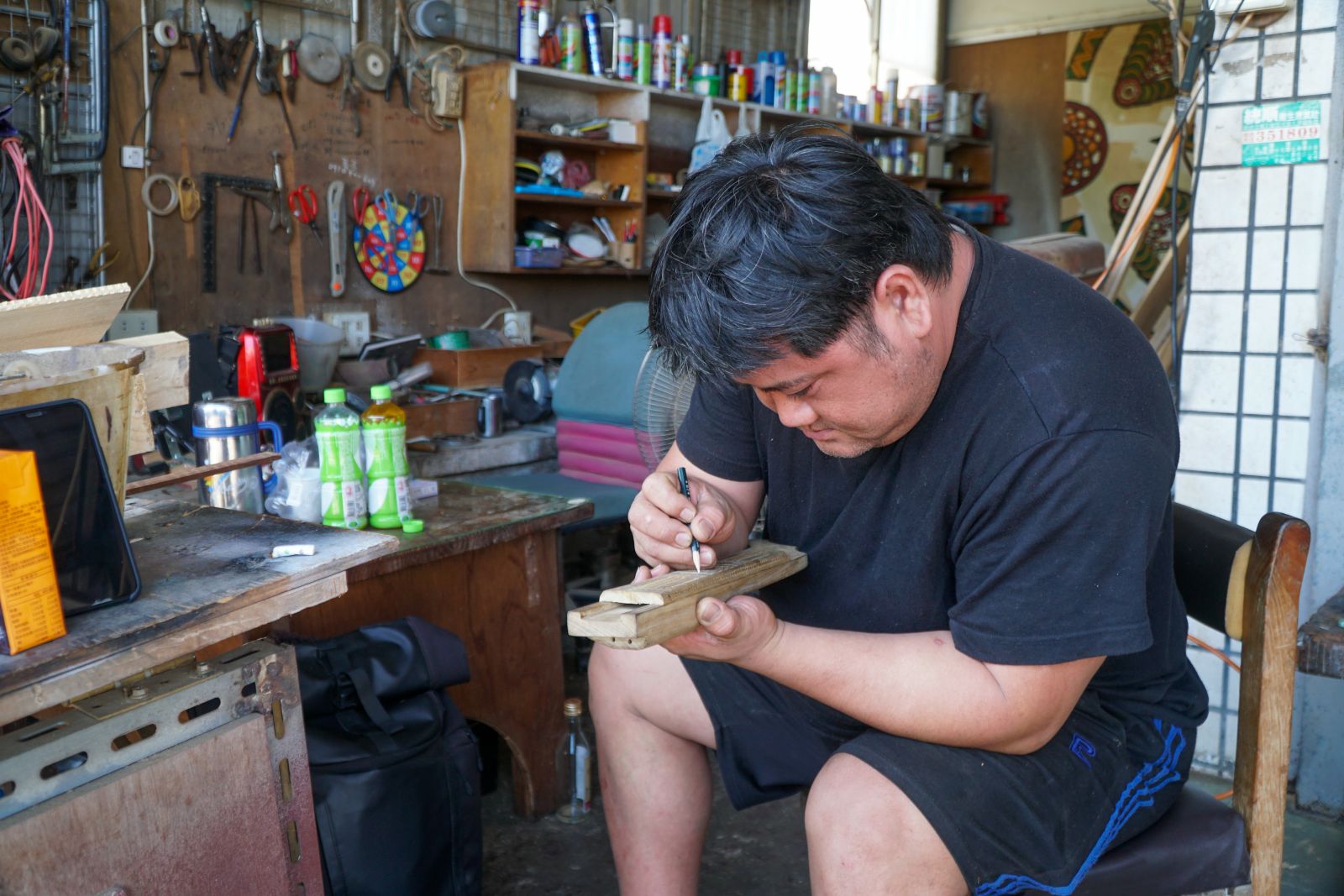
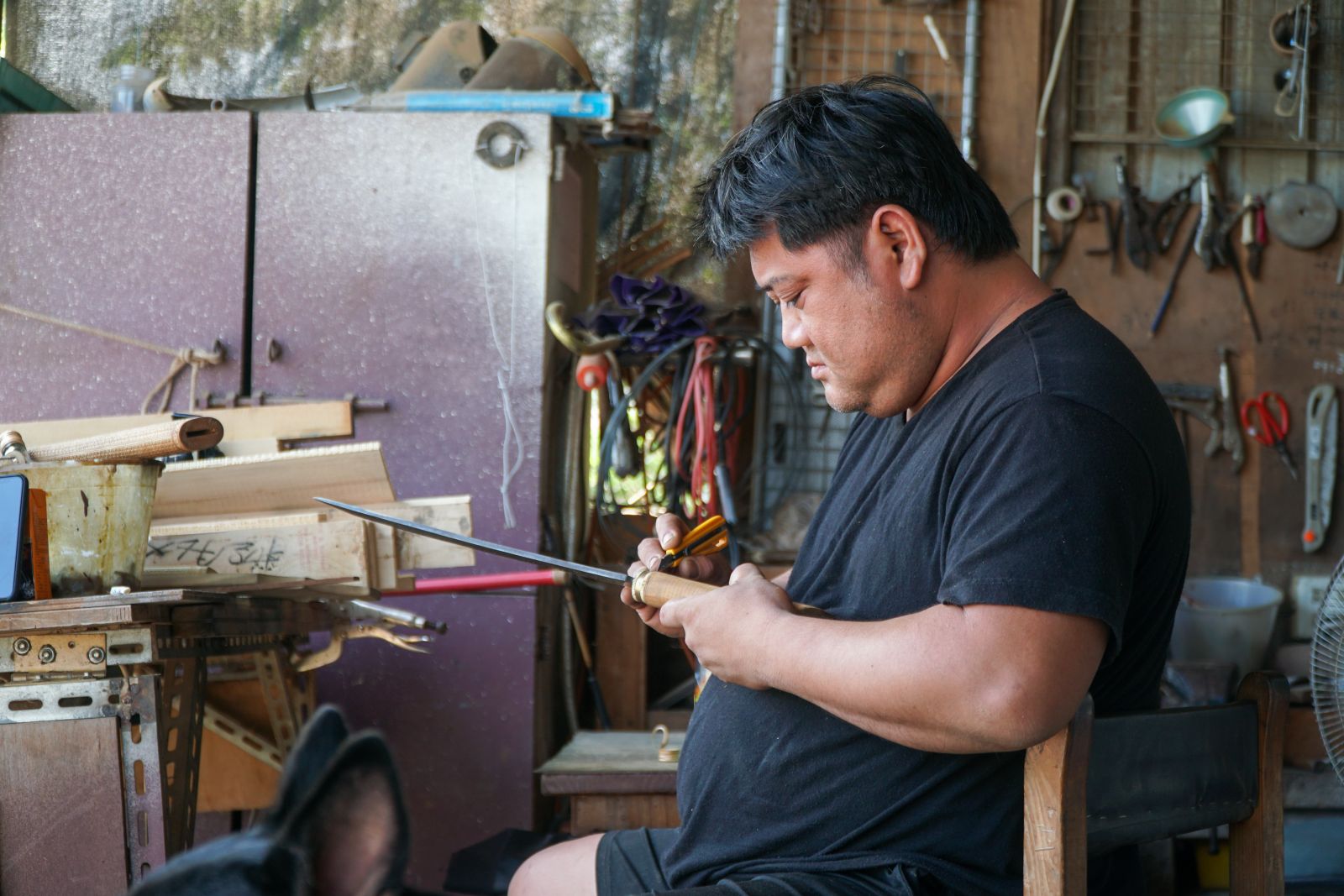
自從專注於佩刀創作後,獻庭深刻體悟到,刀的每個細節都是學問,比如最簡單的刀鞘形狀,他重複畫了約莫一年左右才獲得老師的認可,無止盡的修改過程難免挫折,但穩扎穩打的訓練,也淬煉出他從細節建構起的審美。除了對基本功的要求外,獻庭的老師也相當重視文化觀念,表明「傳承」與「創作」必須分開看待,若選擇雕刻傳統圖紋則不可隨意竄改,才不會違背祖先流傳下來的精神,反之,若為創作則沒有限制。因此我們可在獻庭的作品中區分出壁壘分明的兩大主題,只要佩刀為傳統刀型,必定搭配傳統圖紋,與此同時,他也不忘創造屬於自己的美學。自從獻庭拜師學習部落工藝後,這是他一直謹遵的原則。
Since Xian-ting focuses on sword sculpture, he realized that every detail of the sword is a branch of knowledge, taking the shape of the scabbard for example, it’s the simplest part in sword sculpture, but Xian-ting had drawn it for one year repeatedly to reach the standard which his teacher set. It was unavoidable to feel frustrated when he faced the endless modification, but just because of the steady and firm practice, Xian-ting constructed his own taste of art. Apart from this, his teacher also paid great attention to the cultural concept, declaring that “inherence” and “creation” should separate. If choosing to carve the traditional pattern, one should never change the content, as not violate the spirit which had passed down by ancestors. On the contrary, if it’s the creation, then nothing is limited. Hence, we could easily distinguish these two main categories in Xian-ting’s works, if the sword is in traditional shape, the scabbard must be with traditional sculpture, and at the same time, he never forget to create something new on his own. Since Xian-ting followed his teacher to learn tribal crafts, he had cautiously complied with these two principles.
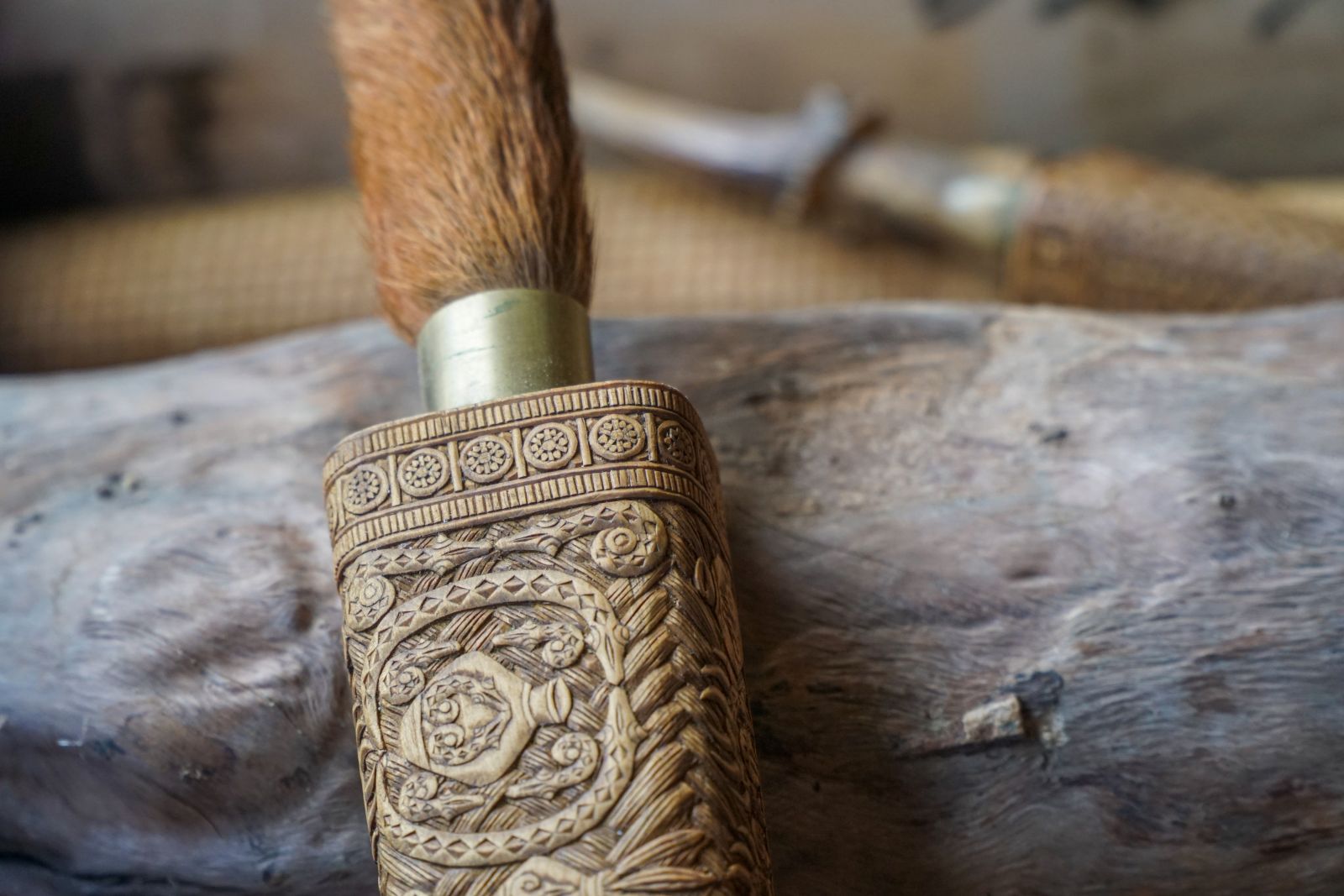
談完創作原則,獻庭說起了最精彩的創作過程!每一次雕刻前,他一定會先畫設計圖,確定圖紋後挑選適合的木材,每種木材的產地、硬度與紋路等特質都不同,這會大大決定作品的底氣,正式雕刻前會再次確認設計圖及木頭紋路是否和諧,微調後才開始動工,而除了刀鞘的雕刻外,刀柄的搭配更具有畫龍點睛的效果。以藤編系列佩刀為例,獻庭在雕刻之前,做了不少前置作業,當他畫完設計圖後,發現要在生硬的木材上刻出柔軟的編織並不容易,所以他向曾祖父學習藤編,深刻了解藤編的重疊、高低、摺痕的樣貌後,才正式選材、動工。而藤編系列的刀柄,則一致選用獵物的身體部位或頭上的角,以意象來說,藤編圖紋的刀鞘如同容器,刀柄則像獵物一般裝載其中,獵人在山野中打獵的神態油然而生。獻庭打造的鬼斧神工,不僅視覺上驚艷眾人,更在文化面涵養深層的底蘊。
After talking about his creation principle, Xian-ting started to talk about the creation process. Before carving, he will definitely do draw design, then select the suitable wood material. Every kind of wood has its own features, including different origin, grain and hardness, and it will substantially determine the quality of the work. After the material selection, he will confirm again that whether the draw design fits in the wood grain or not, do some adjustment then start the carving work. In addition to this, the collocation of the knife handle adds the finishing touch all the time. Take rattan-series sword for example, Xian-ting had done a lot of preliminary work. When he finished the draw design, he found that it’s not easy to shape a soft rattan image on rough wood, so he asked his great-grandfather to teach him how to weave the rattan, after he fully understood all marks, creases and overlaps, he finally had the concept to started the material selection and wood carving work formally. And he always chooses body parts or horns of the prey as the knife handle of rattan-series swords, because when deeply talking about symbols, we’ll find that rattan-pattern scabbard is like container, and the knife handle is like prey inside it, the image of hunters in the wilderness arises spontaneously. Xian-ting’s craftsmanship is not only visually stunning, but also culturally profound.
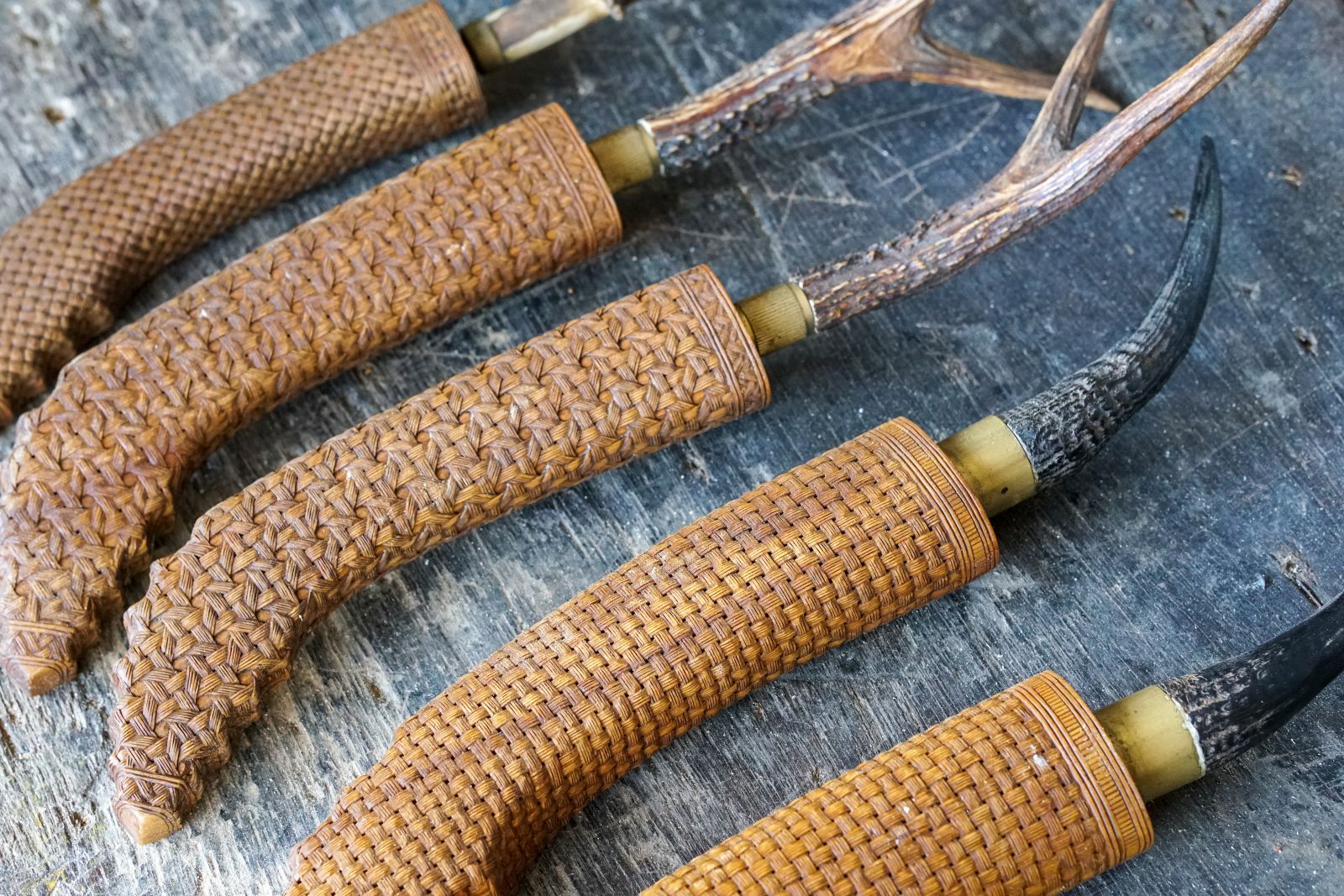
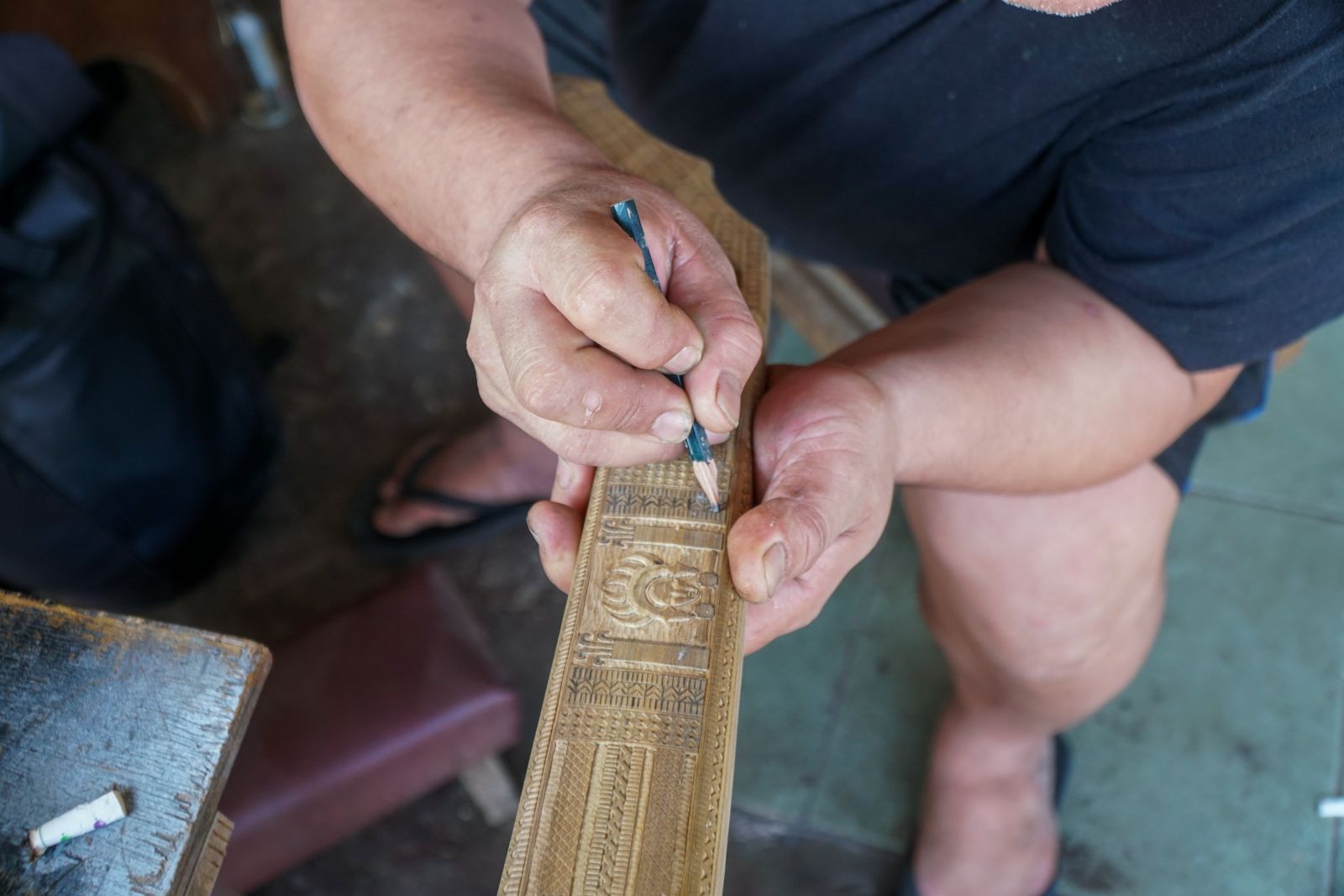
「一直以來,我們都在唱祖先流傳下來的歌,什麼時候輪到我們創作給老人家聽?」獻庭說,這是桑布伊(Sangpuy Katatepan)某次談話提到的想法,當下深受感動,也在他心中埋下一顆小小的種子。十年前,獻庭因緣際會到紐西蘭旅遊,於當地圖書館閱覽書籍時,看見毛利人因銀蕨的根莖會生成澱粉而將其視為生命之樹,更進一步將其轉化為圖騰並應用於生活,當下獻庭受到了很大的啟發!回台灣後,他將筆筒樹轉化為幾何圖騰,在提筆的每個當下,埋在心中的種子漸漸發芽,他終於明白這正是他心之所向,他想做的不僅是延續祖先的智慧,更希望創造反應當代部落生活的圖騰,期許藉由藝術的力量拉起世代之間的連結,他相信當這股文化能量確實積累,卑南之美也將在往後的歲月中日益茁壯。最後,獻庭說他很喜歡一句話:「刀,是回家的鑰匙。」從日常運用、深刻了解到獨立創作,獻庭與刀的旅程相當不凡,當他越靠近文化,就越謙卑學習,但不管走了多少路,方向總直直向家行,不偏不倚。
“We sing the songs which were passed down by our ancestors all the time. When is our turn to sing our creation for them?” Xian-ting told us, this idea came from Sangpuy Katatepan, at that time, Xian-ting was deeply moving by the words, and it sowed a seed in his mind. Ten years ago, Xian-ting traveled to New Zealand, and read books in the local library, he saw the information that Māori regards silver fern as the tree of life because its rhizome could generate starch, then they transforms it into totems and apply in daily life, Xian-ting was totally inspired! Therefore, when he went back home, he transformed the scaly tree fern into a totem, and in the period of drafting, the seed in his mind gradually sprouted, he finally realized that this is where his heart led. He wanted to not only inherit his ancestors' knowledge, but also create the totem or pattern which reflects contemporary tribal life, hoping to reconnect the generations through the power of art. He believes that when this cultural energy accumulates well from generation to generation, the beauty of Pinuyumayan will grow stronger and stronger in times to come. In the end, Xian-ting said “The sword is the key to home.” From daily usage, deeply understanding to independently creating, It’s a remarkable ride to listen to Xian-ting’s journey with sword. The closer to culture, the more humble he was, but no matter how long he has walked, the direction is always home undoubtedly.
